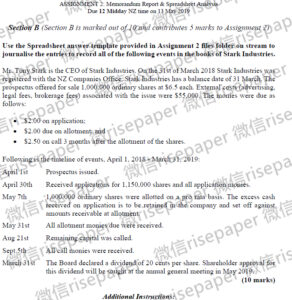The University of Western Ontario
DAN Management and Organizational Studies
MOS 3311: Advanced Corporate Finance
GROUP PROJECT代写,是个最近接到的为数不多的调理十分清晰,写起来十分高效,合作十分默契的小组作业

这门课可以放心下单,像快递小哥一样不惧风雨,每时每刻,准时送达!订单大量涌来,工作室启动超级加速,加油呀!
锐泽代写的专家绝对是有经验的老手,速度快,善于抓住导师的考察思路和套路,帮助您不再被困扰!
熬夜也是一项很耗费体力的体育项目,
祝愿大家早日退役,毕竟,早睡早起才是我们最好的归宿,
锐泽代写,您的留学避风港!
漫漫留学路,殊途同归,祝愿大家顺利完成学业!
TOPIC 3 – RISK AND RETURN
BIG QUESTIONS: What is the risk profile of the company? Provide a qualitative and quantitative analysis of the company’s risks and costs of capital.
Risk and Return Basics
• Obtain an estimate of the expected return and standard deviation for the company’s stock. How would you characterize total risk for potential investors in the company’s equity?
• What is the performance profile of an investment in this company? What return would you have earned investing in this company’s stock? Would you have under or out-performed the market?
• Obtain an estimate of the risk-free rate and the expected return on the market portfolio.
Estimating the Cost of Equity
The CAPM – Regression Beta
Run a regression of returns on your firm’s stock against returns on a market index, or alternately, if you have access to Bloomberg, go into the beta calculation page and obtain the relevant output (suggestion: in either case, use monthly data and 5 years of observations).
• What is the intercept of the regression? What does it tell you about the performance of this company’s stock during the period of the regression?
• What is the slope of the regression? What does it tell you about the risk of the stock?
• How precise is this estimate of risk? (Provide a range for the estimate).
• Search for alternate estimates of beta for your company. How do they differ? How reliable are they?
• What portion of this firm’s risk can be attributed to market factors? What portion to firm-specific factors? Why is this important?
• How much of the risk for this firm is due to business factors? How much of it is due to financial leverage?
The CAPM – Fundamental Beta
• Consider the firm’s business components, and obtain an estimate of business beta for each component if the firm has stated business components.
• Attach weights to each component and estimate a levered and an unlevered beta for the business.
Cost of Equity
• Which of the beta estimates that you have obtained for the firm would you view as more reliable? Why?
• Using the beta that you have chosen, estimate the expected return on an equity investment in this company.
• How risky is this company’s equity? Why? What is its cost of equity?
• As a manager in this firm, how would you use this expected return?
Estimating Cost of Debt
• Does your company have the ability to service its existing debt load?
• If your company has bonds outstanding, what is the yield to maturity on a long term bond?
• If your company is rated: What is the most recent rating for the firm? What is the default spread and interest rate associated with this rating?
• If your company is not rated, does it have any recent borrowings? If yes, what interest rate did the company pay on these borrowing?
• Are there any alternative ways to estimate the cost of debt?
• How risky is this company’s debt? What is its cost of debt?
• What is the company’s marginal tax rate?
TOPIC 4 – CAPITAL BUDGETING
BIG QUESTIONS: How effective is the company at making capital budgeting decisions? What process is used to choose investments? How successful have previous investments been relative to expectations? What are the implications for future growth?
• What methods (NPV, IRR, Payback, Discounted payback, or other) does the firm use to make investment decisions?
• Is there a typical project for this firm? If yes, what would it look like in terms of life (long-term or short-term), investment needs and cash flow patterns?
• How good are the projects that the company has on its books currently? Are those projects providing a tax shield?
• Have recent investment projects added value to the firm or destroyed value? If so, can you estimate how value was added or reduced?
• Are the projects in the future likely to look like the projects in the past? Why or why not? How will these projects affect the firm?
• Estimate the company’s operating cash flows for the latest year for which you have data. How may these, and total cash flows, change going forward?
• Are there any real options in the firm? If so, what type?

